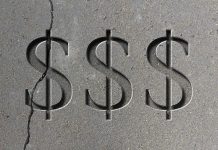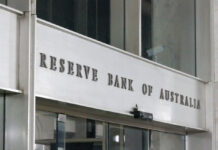The confidence of optimists predicting a V-shaped recovery in the global economy post coronavirus, took a hit on Friday, with equities and energy tanking, and a notable rush into haven assets. No joy was received over the weekend either, with a spike in coronavirus cases in South Korea, and new clusters emerging in Iran and Italy.
Much will now rely on the success of Japan, South Korea, Iran and Italy’s efforts in controlling the spread, even as the rate of new cases in China continues falling. A biological whack-a-mole scenario, where the pathogen is managed in one location, only to pop up in another, is somewhat of a nightmare scenario. Next week’s PMI data from around the globe will give investors the first real insight into the hit to economic activity across the world from coronavirus. A coronavirus booking around-the-world airline tickers make a V-shaped recovery look more like a very wide and shallow U-shape, or at worst, an L-shape.
Global bond markets never really got on board with the post-US-China trade agreement euphoria. Germany’s yield curve is negative from here to eternity, now joined by the Netherland’s. Even Italy and Greece can raise 10-year money at under one per cent. US 30-year Treasury yields fell to 1.88% on Friday, an all-time low, before climbing back above 1.90%. China-centric Australia and New Zealand can expect the same treatment this morning after their currencies took a beating last week on China growth fears.
Wall Street stock markets were carried off a half-time on Friday and gold surged yet again as investors went safe-haven 101. They piled into precious metals and high-grade government bonds, read US Treasuries, and out of equities and energy. With Japan closed for the Emperor’s Birthday, the resulting loss of liquidity is likely to exacerbate moves today. Those will almost certainly be a continuation of the rush for the exit door we saw from Friday’s New York session.
The race for the Democratic Presidential nomination won’t lift the mood either. Bernie Sanders won emphatically in Nevada over the weekend. Being a closet champagne socialist, I like some of the things Bernie has to say in all honesty. However, I am not a voter, and it takes a once in a generation politician to win the US Presidency on a platform of raising taxes. I don’t think Bernie is that guy. With the Democrats seemingly hell-bent on putting up yet another candidate who can’t beat Donald Trump, markets will also have to adjust to the reality, that the world’s first orange president, may well be a two-term one. We can expect more trade wars and trillion-dollar deficits.
President Trump is in India this week on a state visit. The likelihood of some sort of trade deal with India emerging is precisely nil. India is grappling with a severe case of stagflation. It is in no mood to open its millions of small businesses and farmers to the US, or any international competition at the best of times, let alone now. It will, however, be entertaining to watch President Trump watching a cricket game with Prime Minister Modi, and then enjoying a vegetarian meal with him.
The week’s data calendar is a noisy one. Most of the data, though is 2nd-tier and predates February when coronavirus officially made its debut on the world stage. Next week will be altogether more interesting, with our first tranche of February numbers, including China, due to hit the wires. Highlights this week are US GDP on Thursday, which also features a Bank of Korea rate decision. A cut and more stimulus measures are most certainly on the cards and will likely weigh on the Korean Won this week.
Wednesday sees Hong Kong announce its 2020 budget and Q4 GDP, which is likely to fall by 3.0%. That will probably look like a great number though, when compared to the probable carnage of Q1 2020 GDP, once it is tallied up. Singapore threw the fiscal kitchen sink at its coronavirus slowdown in its budget last week. Hong Kong, grappling with a protest-induced recession already, plus a coronavirus right hook, should be doing the same. Sadly, the Government’s decision making on any issue hasn’t set the world on fire over the last year, just some of its neighbourhoods. With such low expectations, anything better than abject disappointment will probably be taken as a win by financial markets.
Equities
Wall Street slumped on Friday as assembled legions of epidemiologists there finally conceded that perhaps this was no longer a China-centric problem. With cash clearly flowing from equities to the safety of US Treasuries, the S&P 500 fell 1.05%, the Nasdaq slumped by 1.80%, and the Dow Jones fell 0.80%.
No respite was found over the weekend, as G-20 Finance Ministers expressed growth worries from Riyadh, and new clusters of coronaviruses appeared internationally.
Asia is a sea of red with Japan closed for a holiday today. The South Korean Kospi has collapsed by 3.0% as coronavirus cases accelerate there, and the Government raised its infectious disease alert level to its highest. The Hang Seng is 1.25% lower and the Straits Times by 0.80%. Australia’s resource heavy All Ordinaries has fallen 2.10% this morning, and the NZX 50 is down 1.30%.
With further drops in infection rates, Mainland exchanges are relatively calm by comparison. The Shanghai Composite has fallen 0.50% and the CSI 300 by 0.30%
With the coronavirus outbreak, and subsequent effective quarantining of over 50.000 people in Northern Italy this weekend, Europe now moves to the frontlines of the outbreak. Extrapolating the reactions of stock markets in Asia/Pacific, ex-China, this morning, Europe looks set for a strongly negative open this afternoon. The realisation of reality versus hope in Asia will keep local stock markets anchored in the red for the rest of today.
Currencies
The US Dollar fell modestly against its developed market counterparts on Friday as US Treasury yields fell and equities sank. However, it made notable gains versus developing markets, with USD/MXN rising 1.20% to 19.0900 today as oil prices collapse. The gains by the JPY and CHF against the Dollar were driven by haven flows, whereas the small increases by the EUR and GBP to 1.0840 and 1.2960 respectively, had a definite temporary correction look about them. Versus developing markets, the Dollar’s strength was most certainly driven by a rotation into haven positioning and US bond and out of emerging markets as coronavirus fears surged.
That pattern is being repeated this morning with the US Dollar making substantial gains regionally today. AUD/USD had fallen to 0.25% to 0.6610, and NZD/USD has fallen to 0.6325 with USD/KRW jumping by 0.55% to 1216.00. USD/SGD has risen 0.20% to 1.4010 and USD/MYR has leapt 0.80% to 4.2130 this morning.
The rush to safety will continue to benefit the US Dollar with its high yields by developed market standards. Even with 30-Year Bond yields below 2.0%, in comparison to Japan, Europe, Canada and Australia, US yields make a compelling case. For that reason alone, the US Dollar will remain strong throughout 2020, unless the Federal Reserve hits the panic button.
With that in mind, and a cluster of coronaviruses now in Northern Italy, gains by the Euro and the GBP will be limited. A coronavirus escalation on the continent will see EUR/USD targeting 1.0500 and GBP/USD targeting 1.2500.
Petro currencies such as the Norwegian Krone, Russian Ruble and Mexican Peso also face a harsh day at the office as oil prices collapse.
Oil
Oil has collapsed in Asia today, with both Brent crude and WTI lower by over 2.60%, following last Fridays approximately 1.25% fall. The escalation of coronavirus infections internationally over the weekend and the subsequent potential slump in consumption. Brent crude has slumped to $56.90 a barrel, and WTI has collapsed to $51.95 a barrel.
It has always been my premise that the rally was built on hope rather than reality, and Friday and today’s moves lower have likely flat-footed OPEC+. Having bet that the coronavirus effect would be temporary, OPEC+ may need to revisit that premise hurriedly. A fall by Brent crude through $55.00 a barrel, will set alarms ringing in the corridors of the cartel and its partners.
Having come such a long way in such a short time and on a Japanese holiday, we may see some profit-taking and a small recovery into early Europe. Rallies though are likely to be limited in scale with sentiment having unequivocally turned negative. Further bad news on the coronavirus front from the areas of international outbreaks, will almost certainly see oil move lower again.
Gold
Gold has soared in Asia, jumping 18 dollars to 1261.75 an ounce this morning, having touched $1280.00 an ounce earlier int he session on panic buying and stop-losses. That follows an impressive New York session, where gold rose from $1620.0 an ounce to $1643.00 an ounce.
The 40 Dollar rise in gold over the last two sessions reflects its haven appeal as coronavirus risks internationally accelerate, and V-shaped recovery hopes fade. And a gold rush by investors to reinstate long positions, having reduced them as it remained marooned between $1550.00 and $1585.00 in January.
The pace of the move higher has been exacerbated by the absence of Japanese liquidity today. But it also highlights the remarkable change in sentiment over the past few days. Gold has resistance at $1680.00 an ounce, the day’s highs, followed by $1700.00 an ounce. Gold has finally established some serious momentum, and more negative coronavirus headlines will see a test of $1700.00 an ounce on haven flows, sooner rather than later.













